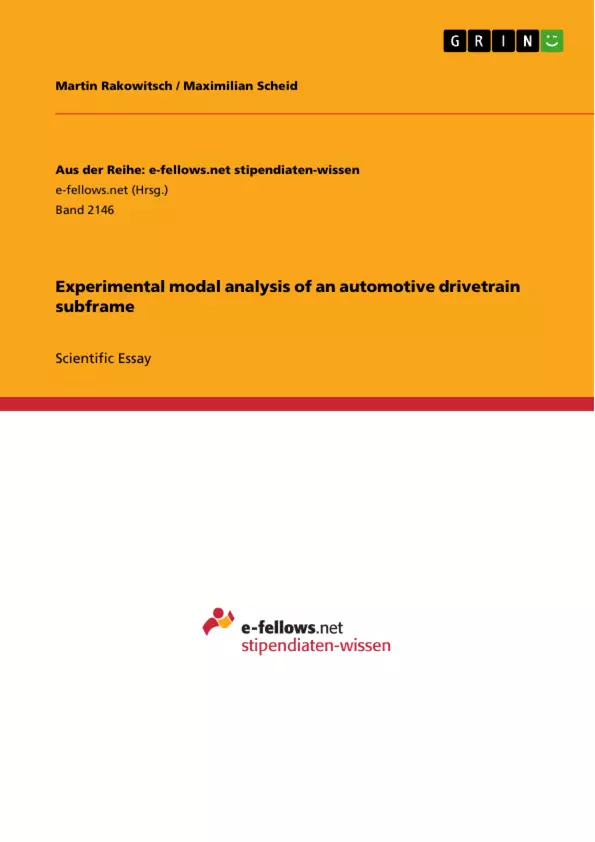Within the framework of this project, the dynamic behaviour of a sub frame sup- porting the rear differential of vehicles is investigated. The original structure, consisting of sub frame and assembled gear, used hard plastic bushings. This setup caused noise inside the passenger cabin, which was not tolerated by customers. In order to obtain a better understanding of the noise’s source, an experimental modal analysis of the structure is performed. After draping a point cloud over the structure, the frequency response functions between these points are measured. The complex exponential method, including Prony’s method, provides algorithms which are used to extract the structure’s modes. Within the frequency range of approx. 50 to 550 Hz seven eigenmodes are extracted. Two of them show strong interaction between sub frame and differential, while the residual modes are dominated by the frame’s mode shapes.
Inhaltsverzeichnis (Table of Contents)
- Introduction
- Laboratory setup
- Signal analysis
- Mode extraction
- Theory
- Application-oriented advises
- Results
- Appendix
Zielsetzung und Themenschwerpunkte (Objectives and Key Themes)
The aim of this project report is to investigate the dynamic behavior of an automotive sub-structure provided by GKN Driveline. Through experimental modal analysis, the report aims to extract the modal parameters of the structure and use this information to animate the eigenmodes, thereby providing a better understanding of its dynamic behavior.
- Dynamic properties of an automotive sub-structure
- Experimental modal analysis
- Extraction of modal parameters
- Animation of eigenmodes
- Understanding of dynamic behavior
Zusammenfassung der Kapitel (Chapter Summaries)
- Introduction: This chapter introduces the test object, the given problem, and the different versions of the structure being investigated. It outlines the aim of understanding the dynamic behavior of the structure with soft bushings and the frequency range of interest.
- Laboratory setup: This chapter explains the laboratory setup, focusing on the suspension of the frame, the placement of measurement points, and the excitation method. It also discusses the sampling frequency, time record length, and averaging functions used in the signal analysis.
- Signal analysis: This chapter explains the signal processing steps involved in obtaining the frequency response functions (FRFs). It describes the filtering, FFT, auto/cross spectra calculation, FRF estimation, and calibration processes.
- Mode extraction: This chapter delves into the theory behind mode extraction from the obtained FRFs. It explains the complex exponential method, including Prony's method, and how it relates the eigenvalues and eigenvectors to the FRFs. This chapter also provides application-oriented advice on the mode extraction procedure.
Schlüsselwörter (Keywords)
The key terms and focus topics of this project report include experimental modal analysis, automotive sub-structure, frequency response function, mode extraction, eigenmodes, dynamic behavior, soft bushings, and noise reduction.
- Quote paper
- Martin Rakowitsch (Author), Maximilian Scheid (Author), 2016, Experimental modal analysis of an automotive drivetrain subframe, Munich, GRIN Verlag, https://www.grin.com/document/342046



